Key Points
- The Banks grass mite (BGM) and the two-spotted spider mite (TSM) are problematic pests for corn producers in the High Plains and Western United States, often causing significant economic injury.
- The amount of economic loss that spider mites cause varies from year to year based on several biotic and abiotic factors and has been documented as high as 47% in corn grain.
- Spider mites damage corn by rupturing leaf cells and drinking the contents out; most damage is done when feeding is on leaves at or above ear level.
- Managing for resistance is a key issue that growers should be aware of when controlling spider mites.
- This Field Facts discusses spider mite lifecycle, plant damage, identification, and management options.
What Are Spider Mites?
Spider mites (Family Tetranycidae, Order Acari) are not insects, but are tiny arachnids closely related to ticks and spiders. They can be problematic pests for corn producers, primarily in the High Plains and extending through the western US. While high spider mite numbers frequently cause significant damage to corn (grain, silage, and sweet), the level of economic loss is different from season to season. Temperature, humidity, rainfall, soil type, pesticide applications, host proximity and natural enemies affect population dynamics from year to year. High temperatures and drought stress generally accompany high populations of mites. Higher populations of spider mites are often found in sandy soil types, as these soils typically incur drought stress in western states, even under irrigation.
Two Common Mite Species in Corn
The two most common and widespread mite species causing concern for corn producers across the Western U.S. (Bynum et al., 1997) are:
- The Banks grass mite [Oligonychus pratensis (Banks)] (BGM) - predominant earlier in the growing season.
- The two-spotted spider mite [Tetranychus urticae Koch] (TSM) - extends later into the growing season.
Spider mites can damage corn from the seedling stage all the way to maturity. Both the BGM and TSM feed primarily on grass species. They can differ in their susceptibility and resistance to insecticides, making them difficult to manage.
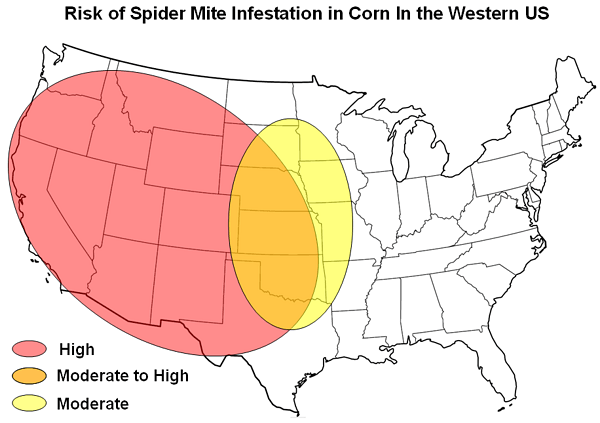
Spider Mite Damage to Corn
The BGM and TSM damage plants by using needle-like stylets to rupture leaf cells, pushing their mouth into the torn tissue and drinking the leaf contents. This results in clusters of dead cells, leaving a stippled or speckled appearance on the upper leaf surface. Concentrated chlorotic areas begin along the midrib and folded areas of the leaf spreading to the basal half of the leaf. In instances of severe feeding leaves will become gray, yellow, bronzed, dry or bleached. High populations of untreated mites will cause loss of vigor and eventual death.
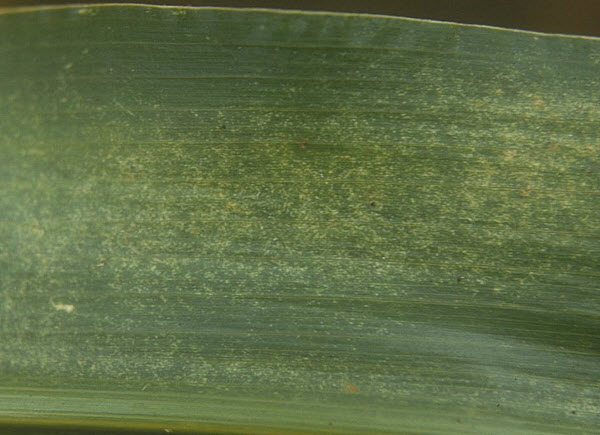
Mottled, discolored corn leaf resulting from spider mite feeding.
Mite activity increases under hot and dry conditions. Crop damage is most severe when feeding occurs on the leaves at or above the ear level between tasseling and hard dough. Yield loss attributed to spider mite feeding may be as high as 40% (on a dry matter basis) in corn silage, and grain losses may be as high as 47% (Archer, et al.). A long-term university study observed yield losses ranging from 6 to 48%, with an 18-year average of 21%.
Biology and Life Cycle
Spider mites have four life stages: egg, larva, nymph, and adult. Mites may occasionally overwinter in crop residue, but primarily the BGM will overwinter in crowns of winter wheat and native grasses. The TSM primarily overwinters in alfalfa and other broadleaf species bordering fields. Beyond that the life cycles of the two mite species are quite similar. When conditions are favorable, overwintering adult females will begin to move into the corn crop by crawling short distances or being carried by the wind.
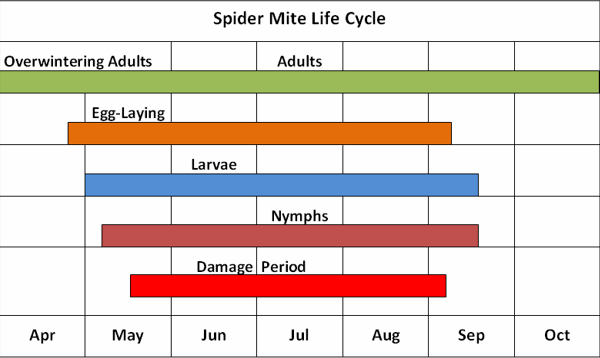
Adapted from Purdue University¹.
Spherical, pearly white eggs are laid and fastened to the underside of the leaf by webbing produced by the adult females. Eggs are minute, will hatch in a range of 3 (75°F) to 19 (50°F) days depending on temperature, and will change in color from pearly white to a yellowish green just prior to hatching. The larvae have six legs, are colorless, and resemble the nymph and adult. Little leaf nutrients are consumed in this stage. The nymph has eight legs, looks like the adult, but is smaller and sexually immature. The nymphs will undergo both a proto-nymph and deutonypmh instar stage. Adults are eight-legged and range in color from bright green to red. Females are 1/60-inch long and are slightly larger and more robust than males, which are only 1/80 inch long.
Spider mites are an arrenotochous species, meaning a female will lay both fertilized and unfertilized eggs. The fertilized eggs will turn into diploid females, and the unfertilized eggs will turn into haploid males. The ratio of males to females can vary considerably from one population to the next but is normally female-biased.
A generation usually proceeds from start to finish in as little as 5 to 20 days, depending on temperature. Hot and dry conditions will increase the rate of development. Optimum temperatures differ slightly for the BGM and TSM. BGM are more fecund in climates with lower humidity and 97 to 98 °F temperatures. However, the TSM thrives in climates with a higher percent humidity and 86 to 90 °F temperatures. BGM populations have been shown to increase 70-fold in one generation. It is typical for both mite species, and all mite stages, to be present with 7 to 10 generations per season overlapping one another.
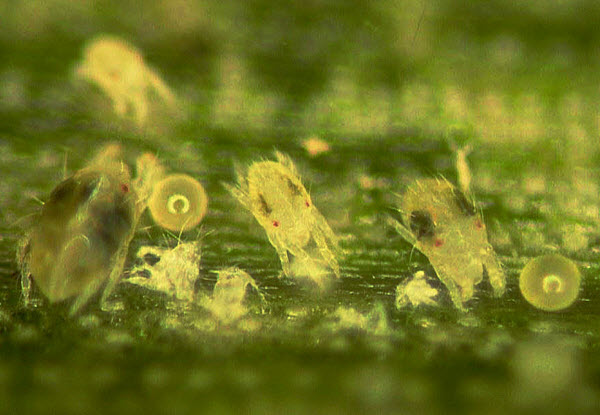
Two-spotted spider mite eggs, larvae, nymphs and adult.
Table 1. Developmental time for spider mites on corn.
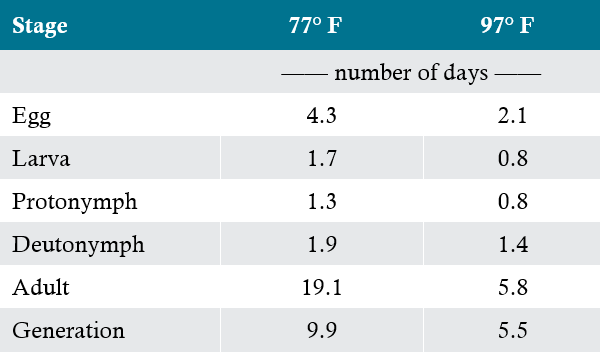
Adapted from Perring et. al., 1983.²
Spider Mite Scouting and Identification Tips
- When: Scouting for spider mites should begin as soon as wheat, alfalfa, native grasses, and broadleaf weeds bordering fields begin to dry down and continue until corn reaches dent.
- Where: Early in the season, scouting plants next to grass waterways, field edges, or stressed areas will give the best indication of whether spider mites are feeding on corn.
- How: Spider mites will produce fine webbing to protect themselves and their eggs. Check the underside of discolored leaves for both the webbing and mites. Mites are small and sometimes hard to see. Taking a white piece of paper and shaking the leaf over it can help to visually identify mite presence.
When scouting, identify which mite species is present. Even though the BGM and TSM are similar in appearance and can appear simultaneously, they have several different biological characteristics and differ in their susceptibility to pesticides (Table 2). The BGM will appear earlier in the season from mid-whorl through the early grain filling stages, and feed mostly on the lower leaves before moving to the upper leaves of the plant. The TSM will appear mid to late season, usually after flowering, and feed over the entire plant. To identify the type of mite present, use a 10X hand lens and observe 20 adult females. It is best to do this procedure in 5 to 10 randomly selected areas in the field. Females will be the largest individuals present and have rounded bodies, while males have a more slender, tapered body.
Table 2. Biological comparison of Banks grass mite and two-spotted spider mite3,4.
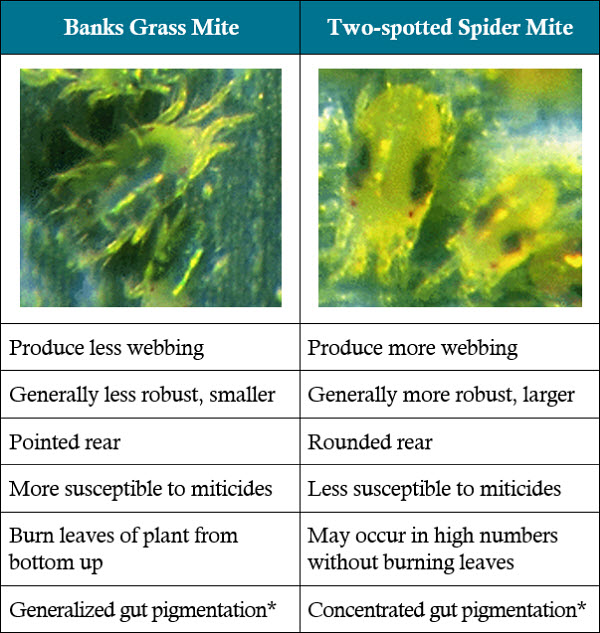
*Visible green markings on spider mites are a result of ingested plant material and differences in gut structure
3Adapted from Peairs, Colorado State Univ. and Holzer and Kalisch, University of Nebraska.
4Images courtesy of University of Nebraska.
How to Control Spider Mites in Corn
The economic damage spider mites can cause varies from year to year and depends on several biotic and abiotic factors. When deciding how best to manage spider mite infestations in a corn crop, consider biological, cultural, and chemical control methods, individually or in combination.
Biological and Cultural Control
In some years, fields may not have to be treated, as beneficial predatory insects keep the mite populations below economic injury levels. Beneficial predatory insects include the Stethorus lady beetles, minute pirate bugs, lacewing larvae, and thrips. In addition to predatory insects, Neozygites floridana, a naturally occurring fungus, is a common pathogen that attacks spider mites and can be beneficial in controlling population numbers. Daily temperatures below 85°F with high relative humidity create favorable conditions for fungal growth on the spider mites.
Hot and dry climates tend to have higher levels of spider mite infestations as natural enemies cannot keep up with increasing spider mite numbers, and the fungal pathogen Neozygites floridana is not as active. Avoiding drought stress with properly applied irrigations is a key cultural control component. However, once spider mite populations are established, irrigation will not decrease the density of the population. Other cultural components to consider are later plantings or planting a fuller season hybrid if these options are feasible.
Chemical Control with Miticides
Biological and cultural control practices can be beneficial but often unreliable. Many growers rely heavily on chemical control. While chemical control can be effective, this method does not come without problems or concerns. The TSM is more tolerant to miticides and is harder to control than the BGM. Additionally, spider mites colonize on the bottom side of the leaves leading to difficulties in application coverage. It is recommended to use three or more gallons of water per acre to increase effectiveness. Aerial applications are most effective. More scouting and secondary treatments can usually be expected, as it is difficult to kill eggs with a miticide application. Re-infestation will likely occur within seven to ten days after initial application.
Only apply miticides when yield is threatened based on treatment thresholds and application guidelines.
Early season preventative treatments can provide some economic benefit. Growers should carefully consider:
- The amount of plants infested with small colonies of mites.
- Temperature and humidity patterns.
- Any drought stress the crop may be under.
- Predatory insect populations.
- Field history of mite infestations.
Again, this places a high emphasis on properly scouting for the pest.
A simple guideline in determining treatment thresholds is to treat when damage is visible in the lower third of the plant, colonies are present in the middle third of the plant, and the corn has not yet reached hard dough stage. Once the corn crop has reached the hard dough to dent stage, no economic benefit will be gained from a miticide treatment.
Another more sophisticated guideline takes into account the cost of treatment and expected crop value based on the percent of infested leaves and the amount of leaf area damaged (Table 3). To use this table, the control cost (miticide + application cost) and the expected crop value (grain bu/acre x market price) must be determined. Then a two-step sampling method is used. First, select an individual plant and check green leaves for presence or absence of mites to calculate the percentage of infested green leaves (first value listed in table). This should be done ten times in different portions of the field. If percent of green leaves infested exceeds that of the control cost and crop value, then the percent of leaf area damaged will need to be determined.
Example: If the estimated control cost is $20/acre, the crop is valued at $300/acre and the percent of green leaves infested exceeds 39, then the percent leaf area damaged needs to be estimated. If the percent leaf area damaged exceeds 21, then it will likely pay to apply a miticide treatment.
Table 3. Economic injury threshold for BGM and TSM in corn*.
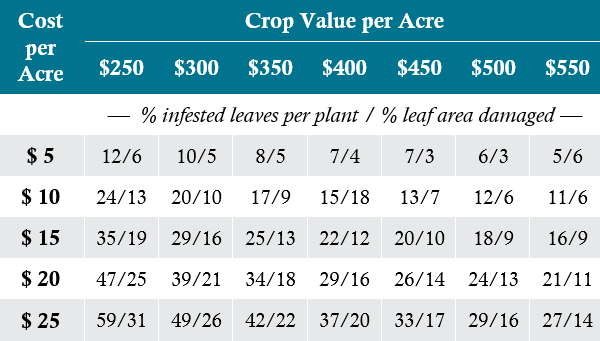
Developed by Archer and Bynum5.
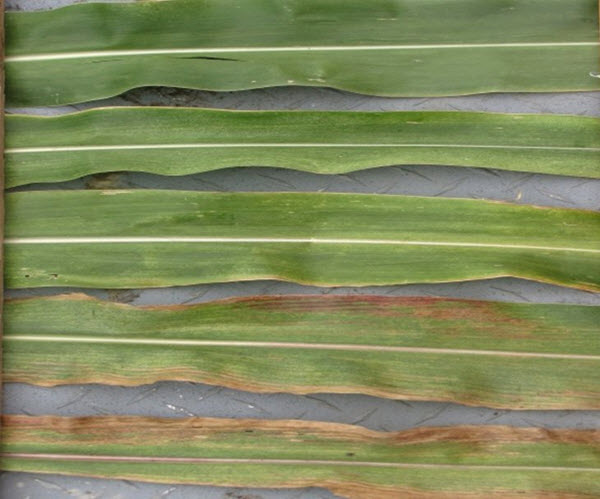
Leaves showing progression of no damage (top) to intense damage (bottom) due to spider mite feeding.
Resistance Management
Because spider mites can develop resistance to miticides, resistance management is a key concern for growers. Continued use of any one miticide will naturally select against susceptible mites and increase the number of tolerant mites in each subsequent generation. In areas where spider mites are a consistent problem, the following resistance management strategies can be extremely helpful.
- If able, keep corn well-watered and avoid drought stress.
- Avoid planting corn next to winter wheat and alfalfa fields, particularly if mite infestations are known.
- Use insecticides only when faced with serious yield loss.
- Beneficial insects that are predatory on spider mites are better able to thrive when insecticides are not used on corn. Planting Pioneer® brand hybrids with aboveground insect protection technologies can help preserve yield potential while reducing or eliminating the need for insecticides.
- Only apply miticides when yield is threatened based on treatment thresholds and application guidelines.
- When miticide applications are necessary, be sure to maximize miticidal activity by applying with the proper carrier volumes and appropriate adjuvants (Table 4).
- Do not consistently use the same miticide year after year.
Table 4. Spider mite management options6.
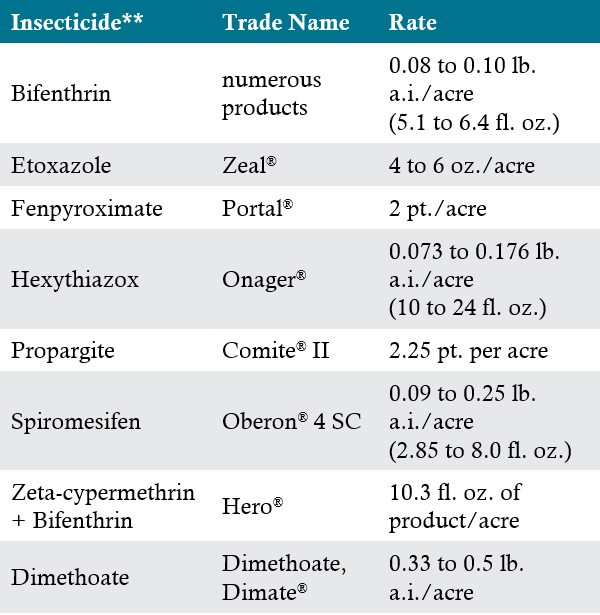
6Adapted from Kansas State University.
**Always read and follow manufacturers label, directions, and recommendations
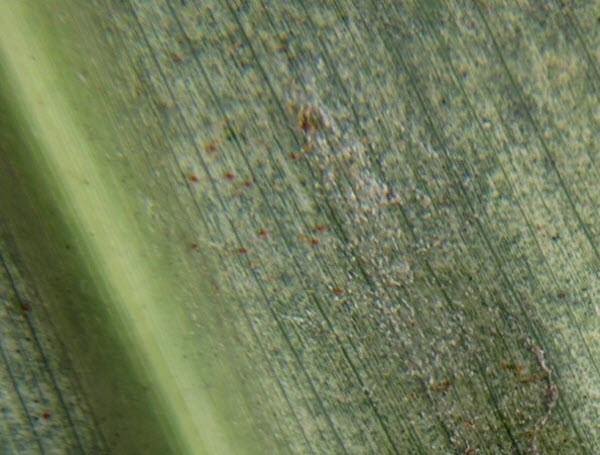
Corn leaf infested by spider mites, showing webbing and damage on underside of leaf.
Acknowledgements and References
- 1Spider mite life cycle - adapted from Purdue University / Entomology / Extension website.
- 2Table 1 adapted from Perring, T. M., T. L. Archer, D.L. Krieg & J. W. Johnson, 1983. Relationships between the Banks grass mite (Acariformes: Tetranychidae) and physiological changes of maturing grain sorghum. Environ. Entomol. 12: 1094-1098.
- 3Table 2 adapted from Peairs, Colorado State Univ. and Holzer and Kalisch, University of Nebraska.
- 4Images courtesy of Wright, R., R Seymour, L. Higley, and J. Campbell, 2006. Spider Mite Management in Corn and Soybeans, NebGuide #G1167. Univ. of Nebraska-Lincoln.
- 5Table 3 from Archer, T.L., and E.D. Bynum, Jr. 1993. Yield Loss to Corn from Feeding by the Banks Grass Mite and Two-Spotted Spider Mite (Acari: Tertranychidae). Exp. & Appl. Acarology. 17: 895-903.
- 6Adapted from Kansas State University.
Other References
- Ayyappath, R., J.F. Witkowski, and L.G. Higley. 1996. Population Changes of Spider Mites (Acari: Tertranychidae) Following Insecticide Application in Corn. Environ. Entomol. 25: 933-937.
- Bynum, E.D., Jr., T.L. Archer, and F.W. Plapp, Jr. 1990. Action of Insecticides to Spider Mites (Acari: Tertranychidae) on Corn in the Texas High Plains: Toxicity, Resistance, and Synergistic Combinations. J. Econ. Entomol. 83:1236-1242.
- Bynum, E.D., Jr., T.L. Archer, and F.W. Plapp, Jr. 1990. Comparison of Banks Grass Mite and Twospotted Spider Mite (Acari: Tetranychidae): Responses to Insecticides Alone and in Synergistic Combinations. J. Econ. Entomol. 90:1125-1130.
- Chandler, L.D., T.L. Archer, C.R. Ward, and W.M. Lyle. 1979. Influences of Irrigation Practices on Spider Mite Densities on Field Corn. Environ. Entomol. 8: 196-201.
- Jones, V.P. 1990. Developing Sampling Plans for Spider Mites (Acari: Tertranychidae): Those Who Don’t Remember the Past May Have to Repeat It. J. Econ. Entomol. 83: 1656-166.
- University of California Agriculture & Natural Resources. Spider Mites.
- Penn State Extension. Two-Spotted Spider Mite on Soybeans and Field Corn.
Early Season Spider Mite Scouting - High Plains
Spider mites can be a problem, and Pioneer Field Agronomist Russell French has advice on how to scout for them.

Get the Latest Insights in Your Inbox
Stay connected to your Pioneer agronomist with our Walking Your Fields® e-newsletter and other communications. It’s your go-to source for timely agronomic information to help add value to your farm management strategy.
Subscribe Now
The foregoing is provided for informational use only. Please contact your Pioneer sales professional for information and suggestions specific to your operation. Product performance is variable and depends on many factors such as moisture and heat stress, soil type, management practices and environmental stress as well as disease and pest pressures. Individual results may vary. Pioneer® brand products are provided subject to the terms and conditions of purchase which are part of the labeling and purchase documents.